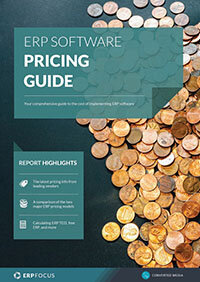9 hidden ERP costs that can blow your implementation budget
You and your ERP selection team have met with various vendors, analyzed everything possible over the months, and now have a selection. The chosen vendor gave you a price and an estimate of your total costs to implement and begin using a new, powerful ERP system. Your management approved the project. Nevertheless, some will be surprised that your best estimate is likely short of the actual cost of implementing the ERP. Recent data taken from ERP projects reported that the average budget per user is $7,200 - a sizeable sum of money to spend if you have a lot of employees, but this isn't always the full picture of your total spend. There are almost always hidden costs to account for.
1. Labor costs
Labor is a major part of ERP implementation. You know up front you will spend a lot of money on labor for the implementation but it is unlikely you will guess right. Try to budget enough.
You will need to convert data from your legacy ERP into formats that your new ERP can use. Every ERP contains a lot of data. You can be sure that data contained in one table must be converted into multiple tables and that data in multiple tables will be used in a single table. People will process these conversions. Some costs can be controlled by limiting the amount of historical data moved. You may also consider using automated conversion processes which will probably help.
Your project team will remain on your payroll and you can expect significant overtime needed. Plus, all of the members of your team had other jobs before they were selected, and those jobs will need to be done. Plan on adding temporary staff and hiring new people to fulfill those jobs.
You will need to supplement your IT staff as well. Every existing system, not only the ERP, needs to continue supporting your business. At the same time, IT people will be needed to support the implementation project.
Many businesses hire consultants from their ERP provider to perform some of the work and to share their expertise during the project. That expertise is invaluable and will take years for your own staff to acquire. Those consultants are not cheap – they will likely bill you at several hundred dollars hourly.
2. Training costs
Training is widely recognized as a major hidden cost. You know it is needed but estimating that cost with any accuracy is difficult.
Your people will learn new processes. Someone will create a purchase order, much as they did with the legacy ERP, but the steps to do the same purchase order in the new ERP will be a little different.
Your people will need to learn new skills. Where you might have copied data to a spreadsheet in the past, your new ERP allows users to build reports and dashboards within the system. This is an example of a new skill that needs to be trained. You should be sure to invest in cross-functional training, afterall, an ERP is an enterprise-wide set of tools. When your receiving clerk processes the receipt of materials for inventory, they are creating accounting transactions at the same time.
A few of us learn completely after the first lesson. Most of us need additional training before we completely embody the lesson. Be ready with secondary training after some time passes – even after the implementation is considered complete. Be sure to have a review process built in to your controls as there will be a few people who thought they were doing the job as trained, but their methods inadvertently veered in an unexpected direction.
ERP implementation projects often take more than a year to complete. Some people will leave the organization during that period and their replacements must be trained to the same standards or the success of your project can be compromised. These ERP costs, and the cost of recruitment, will be laid at the feet of you and your project.
Follow our ERP implementation guide and make your ERP project a success.
3. Testing, retesting and testing again
Test your new ERP continuously during the implementation project. Begin with simple, single operation tests such as recording time against a job in progress. Test using the new ERP with data converted from your legacy system. Record exactly the steps taken and give each test a green, yellow, or red light score. You will find there was some default set up that caused some errors. You will find the converted data did not fit into the schema as expected. You will fix the problem and test again.
You need hundreds, if not thousands, of these test scripts that check every process in every functional area.
Once you are satisfied with the single step test scripts, begin to combine them across multiple functional areas. Combine them, too, within functions. Accounts payable knows how to record a supplier invoice, but can they make a payment on that invoice too? Continue combining scripts until you can test an entire flow of processes from order to cash. Begin with a new purchase order from a customer, build the product or service they requested and pay your suppliers, deliver the order, and accept a payment to complete the process flow.
Automated testing applications are available and should be strongly considered. These run all day every day retesting the same scripts. Often, the correction you developed to make one script run successfully causes some other script that passed with flying colors yesterday to crash today. There is almost no possibility to test too much; failing to do so could incur significant unexpected cost later.
4. Re-engineered processes
Many businesses try to remove process re-engineering from their ERP implementation process. The idea is to get the implementation complete in the shortest time with the least changes required. The truth often is that none of us have fully optimized all our processes and there will be one or more we have put aside for too long already. In fact, the new ERP you chose probably has some of the best practices built in with the assumption by the developers their client companies will want to use that best process. Does it make sense to customize your new ERP to continue a process you really do not want to continue?
Consider taking this opportunity when your employees will need to adapt to a new system anyway to ask them to adopt a better process at the same time. You’ll find re-engineering a process a lot cheaper than the alternative of customization.
5. Employee resistance to adopting a new ERP
Change is difficult for many of us. A few will recognize improvement and quickly adapt to the change required by the new ERP. There will be some who completely reject the change and might even try to sabotage your efforts. Most will be somewhere in the middle – that is, they will follow the leaders willingly but need some help.
Consider adding a change management specialist to your implementation team. These people are trained in the psychology and sociology related to organizational change. They will help you recognize the person who needs a simple “Thank You”, and differentiate them from another person who needs a lot of handholding to get past their reluctance to change. Under training, we mentioned the need to have an internal process to identify those few who regress and stop using the new ERP as designed and ignore their training. This will happen and you want to identify these few individuals and get them back on the desired track as soon as possible, or you face the added cost of fixing process errors later.
The very few who completely reject your system might find themselves no longer a part of your future organization. All of us must move in the same direction to maintain our unified strength.
6. Customization and integration
Customization means you choose to modify the ERP you selected to fit some need that ERP does not address. Be cautious, the developers of that ERP tried to incorporate best practices from around the globe. The unmet need could already be built into that ERP. Sometimes the screens show wording that does not follow the APICS dictionary but the difference is only words. Sometimes the developer already has an optional module that will satisfy that unmet need. If necessary to support your business model, proceed with that customization. Whatever your estimated cost, it will certainly cost more and take longer than planned.
Integration is another practice related to customization. Your ERP meets all your needs except that it does not offer a web storefront. There are several web store applications available but you will need to move those sales to ERP for fulfillment and you must move the payment into your accounting system. Sales people will say that web services and EDI are robust processes that will make the integration easy and fast. It will not be that easy!
Use our free features guide to identify your requirements for an ERP system
7. Customer dissatisfaction
This one is hard to predict and your implementation might not incur this hidden cost. Murphy will be part of your implementation team and Murphy will try to ensure something goes wrong. If that something is a new order you miss or deliver late, your customer will be dissatisfied. Your response: make certain you have a rapid-response team ready to react and that you can still enter orders and ship them the old-fashioned way during the implementation period. Planning ahead for delays will reduce the likelihood of losing customers, and their revenue, during your implementation.
8. Hoped-for cost reductions
You and your selection and implementation team justified the project based on new, profitable capabilities and cost reductions that would quickly pay for the project. Keep a close watch on these expectations and do what is possible to ensure they yield the hoped-for results. Your management will be watching. Be tough too. Cost savings often mean a reduction in force to save those costs. Plan ahead and throttle back hiring as part of the implementation or take other actions to achieve the project goals.
Some of the expected benefits take time to become visible. Be sure to communicate to your users and your management that more benefits are on the horizon.
9. Ongoing support and maintenance costs
The money you pay up front is only a down payment. ERP providers typically charge maintenance fees that cover support calls and which your users will need. Support costs also include bug fixes and continued improvements to the basic system. Many projects require costs to upgrade hardware and infrastructure to allow the ERP to deliver the benefits you want. That hardware wears out and will require upkeep and maintenance over time.
I hope that identifying these ERP costs will help you budget for your project. It will be expensive and will provide you with a valuable tool to help your business. Remember too, there are some hidden benefits to cancel out some of your hidden costs.
Free white paper

ERP Software Pricing Guide
Get the latest pricing information on over 80 popular ERP systems, and learn how to budget for your ERP project in our free guide

Featured white papers
-

ERP Software Pricing Guide
Get the latest pricing information on over 80 popular ERP systems, and learn how to budget for your ERP project in our free guide
Download -

ERP Implementation: 9 steps to success
The 9 proven steps you should follow when implementing ERP
Download -

Calculating ERP ROI: 5 steps to success
Calculate your new ERP's financial benefits with this comprehensive guide
Download
Related articles
-

Top 10 causes of ERP implementation failure (and how to avoid it)
Few people in an organization ever understand how difficult an ERP implementation is, and how a f...
-

CMMC Compliance: What Aerospace and Defense Manufacturers Need to Know
Key insights on CMMC compliance, deadlines, and securing DoD contracts with CMMC 2.0 certificatio...
-

The case for multi-tier ERP implementations
Learn more about multi-tier ERP implementation and why you might need one

